The concept of flying cars has intrigued many for decades, sparking debates on the feasibility and practicality of this futuristic mode of transportation. While significant progress has been made in the development of flying cars, challenges such as safety, infrastructure, and public acceptance remain prevalent. As technological advancements continue to push boundaries, the question lingers: will cars ever truly take to the skies? The evolving landscape of urban mobility and the potential benefits of airborne transportation leave us pondering the possibilities and limitations of this innovative yet complex endeavor.
Key Takeaways
- Electric flying cars can significantly reduce CO2 emissions, aiding in the fight against climate change.
- Collaboration between regulators and industry is crucial to address challenges in integrating flying cars.
- Advancements in technology and infrastructure are essential for the economic viability of flying cars.
- Societal benefits include improved transportation efficiency, accessibility, and economic opportunities with the advent of flying cars.
History of Flying Cars
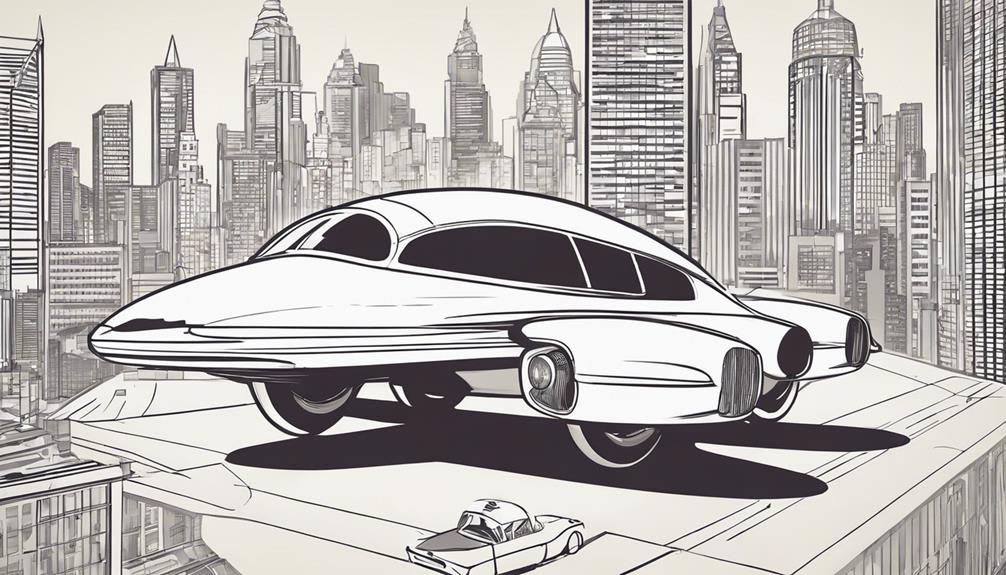
The history of flying cars traces back to early 20th-century innovations in aviation and automotive engineering, marked by groundbreaking attempts such as Glenn Curtiss' autoplane in 1917. These early endeavors set the stage for the ongoing pursuit of combining the capabilities of cars and airplanes into a single, versatile mode of transportation. Fast forward to 2018, Aston Martin's unveiling of the Volante Vision Concept at a staggering price of $9.3 million highlighted the luxury segment's growing interest in flying cars, showcasing a shift towards more advanced and luxurious designs in this sector.
As Lacuna Technologies' CEO predicts the commercial availability of flying cars by 2024, it becomes evident that the concept of flying cars is not merely a futuristic idea but a tangible reality on the horizon. However, several design challenges persist, including the need to seamlessly integrate car and airplane requirements, address high power demands for vertical takeoff, and carefully consider energy sources for sustained flight. Overcoming these obstacles while meeting international aviation and road traffic standards will be crucial in ensuring the safety, reliability, and overall success of flying cars in the future.
Technological Advancements Needed
Advancements in power source innovation and aerodynamic design enhancements are critical factors for the successful development of flying cars. Improving the efficiency and reliability of propeller motor systems will be essential to address stress differentials and ensure safe operation. Overcoming limitations in specialized components, size, weight, and cost constraints will also play a significant role in advancing the technology needed for flying cars.
Power Source Innovation
Innovative advancements in power sources, particularly in electric batteries and efficient engines, are pivotal for the realization of flying cars in the realm of transportation technology. To achieve this, the following key points must be considered:
- Battery Technology: Lightweight, high-capacity batteries are essential for providing the necessary power for sustained flight and enabling vertical takeoff and safe landing.
- Efficient Engines: Development of fuel-efficient engines is crucial for maximizing the performance and range of flying cars while ensuring operational safety.
- Emission Reduction: Electric propulsion systems not only contribute to lower operational costs but also play a significant role in reducing emissions, promoting sustainability in flying car operations.
These advancements in power source innovation are fundamental for the practicality and efficiency of future flying car technologies.
Aerodynamic Design Enhancements
Enhancing aerodynamic design for flying cars necessitates a focus on advanced materials and innovative wing configurations to optimize lift and control during flight. The use of advanced materials like carbon fiber composites and lightweight alloys is crucial for improving aerodynamic performance in flying cars. Additionally, incorporating advanced wing designs, such as fixed or variable geometry wings, can enhance lift and stability, especially in varying flight conditions. Streamlining the body shape and reducing drag through innovative design features are also essential for boosting overall aerodynamic efficiency in flying cars. To achieve these enhancements, utilizing advanced wind tunnel testing and computational fluid dynamics simulations is necessary to fine-tune aerodynamic characteristics and ensure optimal flight performance for flying cars.
Challenges in Regulation and Infrastructure
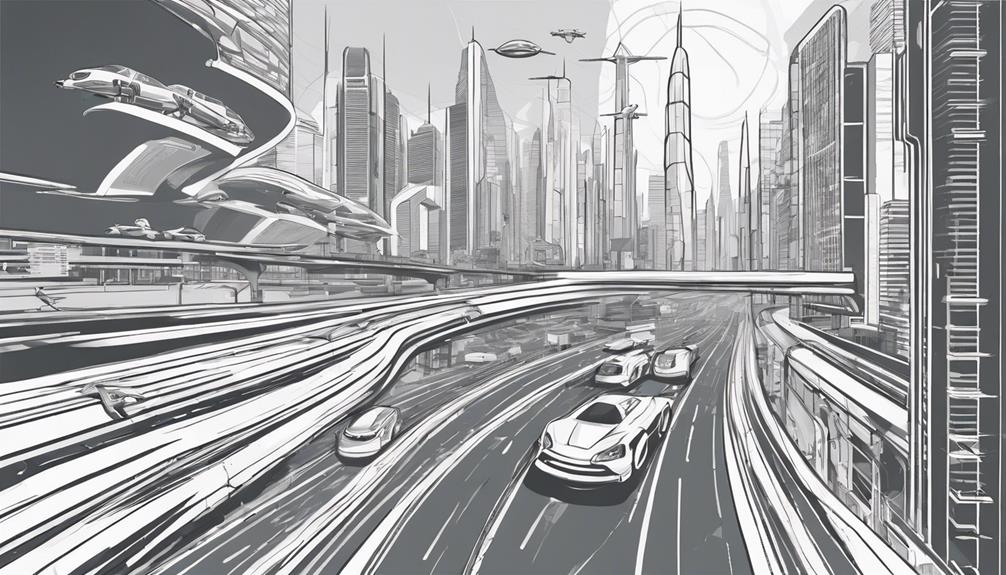
Regulating flying cars poses a complex task due to concerns regarding noise, pollution, security, sustainability, and affordability. Uncertain licensing requirements for passengers and drivers further complicate the integration of these vehicles into urban settings. Infrastructure challenges, such as the lack of trajectory route planning and noise pollution mitigation, highlight the necessity for collaboration among regulatory bodies and industry stakeholders.
Regulation Hurdles Ahead
Navigating the complex regulatory landscape for urban air mobility presents formidable challenges that must be meticulously addressed to facilitate the integration of flying cars into existing transportation systems.
Key Challenges in Regulation and Infrastructure:
- Urban air mobility operations fall under the jurisdiction of the air navigation service provider, necessitating strict regulatory compliance.
- Concerns regarding noise, pollution, security, sustainability, and cost significantly influence the regulation of flying cars.
- Uncertainty surrounding licensing requirements for passengers and drivers poses obstacles to the seamless integration of flying cars into current transportation networks.
Collaborative efforts between entities such as NASA, FAA, and industry leaders are focused on predicting noise levels in urban air mobility. The need for comprehensive regulatory frameworks is underscored by cities regulating commercial air mobility services through business licenses.
Infrastructure Gaps Exist
Infrastructure gaps in urban air mobility present significant challenges that must be strategically addressed to support the integration of flying cars into existing transportation systems. The establishment of an efficient air taxi system requires a robust regulatory framework that addresses jurisdictional issues, noise, pollution, security, sustainability, and cost concerns. Uncertainties surrounding licensing requirements for both passengers and drivers further complicate the seamless incorporation of air taxis into urban environments. Moreover, the absence of adequate provisions for flying car trajectory route planning underscores the pressing need for infrastructure development. Collaboration among key stakeholders such as NASA, the FAA, and industry experts is essential to develop models that can accurately predict and mitigate noise levels associated with urban air mobility operations.
Safety Concerns and Solutions
Ensuring the safety of flying cars requires meticulous path and trajectory planning to mitigate potential collisions at high speeds. The Federal Aviation Administration (FAA) plays a crucial role in setting guidelines to enhance safety measures for air taxis and flying cars. Here are three essential safety concerns and solutions:
- Collision Avoidance Systems: Advanced technologies such as radar, lidar, and cameras can be integrated into flying cars to detect obstacles and prevent collisions.
- Air Traffic Management: Implementing efficient air traffic control systems specific to flying cars can help regulate the flow of traffic and reduce the risk of mid-air collisions.
- Safety Regulations: Government oversight and regulations are essential to ensure the safe operation of flying cars, including noise control measures and designated flight corridors.
Environmental Impact of Flying Cars
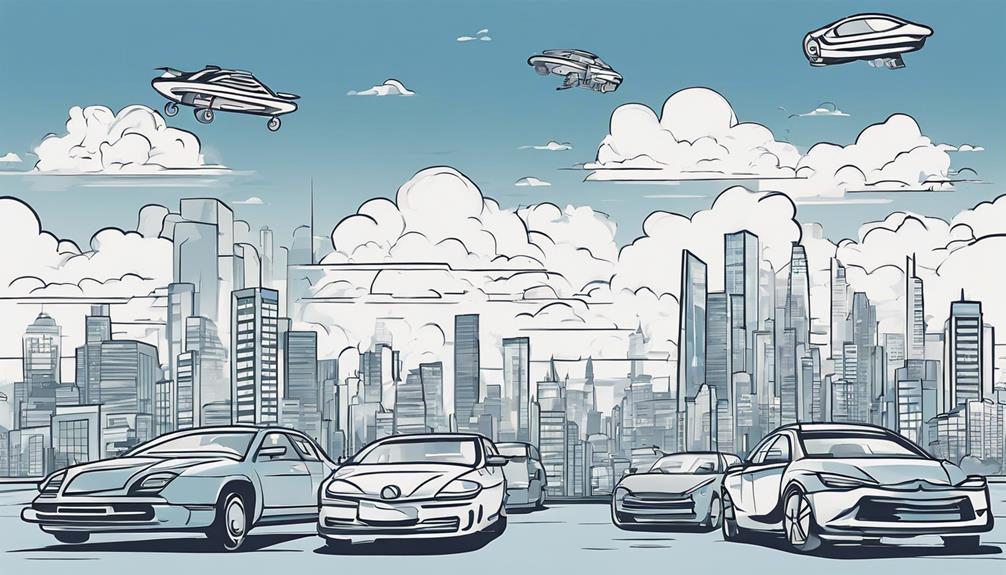
The environmental impact of flying cars is a critical aspect to consider, particularly in terms of air and noise pollution. The shift towards electric-powered flying cars presents an opportunity to significantly reduce carbon dioxide emissions, which could help mitigate climate change. Understanding and addressing these factors are vital in promoting the adoption of flying cars as a more sustainable mode of transportation.
Air Pollution Concerns
Studies have indicated that the adoption of electric-powered flying cars could significantly mitigate carbon dioxide emissions by 35-52%, offering a promising solution to address air pollution concerns associated with traditional transportation modes. Electric flying cars present a potential solution to combat climate change by reducing harmful emissions. The University of Michigan and Ford Motor Company studies emphasize the environmental benefits of transitioning to flying cars, marking a shift towards more sustainable transportation options. The environmental impact of conventional vehicles, especially in terms of air pollution, is a growing concern, making the development of electric flying cars even more appealing. By utilizing electric power, flying cars can play a crucial role in reducing pollution and aligning with global efforts to combat climate change.
Noise Pollution Effects
In urban environments, the environmental impact of flying cars extends to concerns regarding noise pollution from the frequent take-offs and landings. Noise pollution from these airborne vehicles can have significant effects on the quality of life for residents, especially in densely populated areas. Here is a table highlighting some key points regarding the effects of noise pollution from flying cars:
| Effects of Noise Pollution from Flying Cars | |
|---|---|
| 1. Disturbance | 2. Health Impacts |
| Flying cars can disrupt the peace and quiet of urban areas. | Excessive noise levels can lead to stress, sleep disturbances, and other health issues. |
| 3. Wildlife Disruption | 4. Regulatory Measures |
| Noise from flying cars can disturb wildlife habitats. | Cities are implementing regulations to control noise levels from flying cars. |
Through collaborative efforts and regulations, addressing noise pollution is crucial for the sustainable integration of flying cars into urban environments.
Economic Feasibility of Flying Cars
Exploring the economic feasibility of flying cars involves a comprehensive analysis of maintenance costs, energy efficiency, infrastructure requirements, and passenger capacity limitations. When considering the economic viability of integrating flying cars into transportation systems, the following key factors must be taken into account:
- Maintenance Costs: Flying cars are likely to have higher maintenance costs compared to traditional ground vehicles due to their complex dual-functionality as both cars and aircraft.
- Energy Efficiency: The energy consumption of flying cars, especially during flight, will be a critical factor in determining their long-term economic sustainability and environmental impact.
- Infrastructure Requirements: Developing the necessary infrastructure such as vertiports and charging stations for flying cars will require substantial investments, potentially influencing the overall economic feasibility of widespread adoption.
These factors, along with considerations like regulatory frameworks and technological advancements, will play a crucial role in determining the economic feasibility of integrating flying cars into everyday transportation systems.
Potential Use Cases for Flying Cars
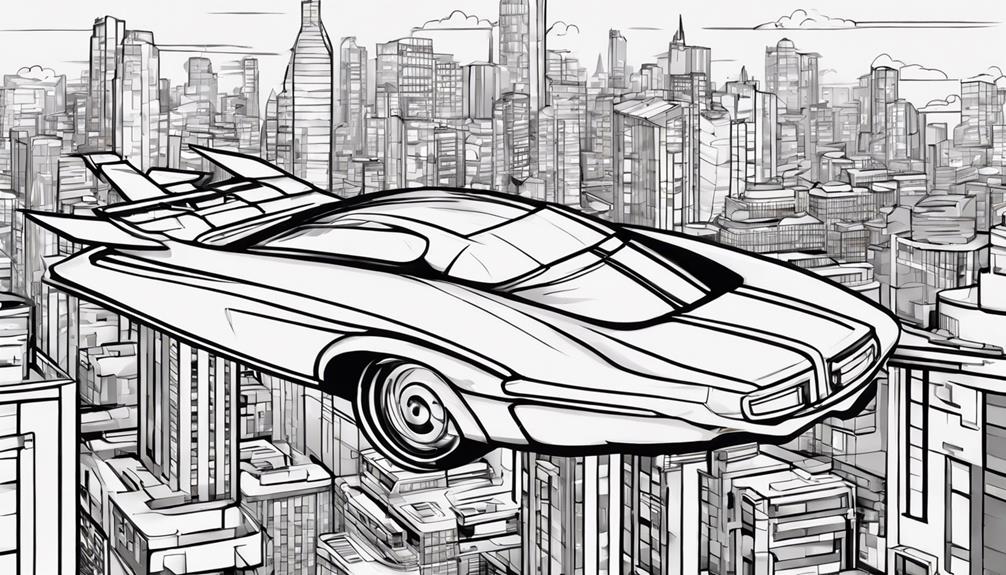
Flying cars present a transformative potential in revolutionizing transportation systems and urban mobility. By taking to the skies, these vehicles have the capability to enable faster and more direct routes, effectively reducing ground traffic congestion. Moreover, their lower emissions compared to traditional vehicles can contribute to a decrease in traffic pollution, promoting environmental sustainability. The introduction of flying cars may also allow for the establishment of dedicated roads for pedestrians and cyclists on the ground, enhancing safety and mobility for these groups. Furthermore, the increased accessibility to all areas facilitated by flying cars could help minimize the risk of vehicle accidents and improve overall transportation efficiency. In essence, the integration of flying cars holds the promise of revolutionizing transportation and urban mobility systems, offering a new dimension to how people and goods are transported within and between cities.
Current Prototypes and Testing
Considering the advancements in technology within the realm of transportation, the focus now shifts towards examining the progress made in developing current prototypes and conducting testing for flying cars.
Current Prototypes and Testing:
- Aska A5 and Alef's flying cars are undergoing testing to assess their flying and road capabilities.
- Aska A5 features large wings and propellers, while Alef's model boasts vertical takeoff and landing functions.
- The Aska A5 offers a range of 250 miles on a single charge, with Alef's car having a road range of 200 miles and a flying range of 110 miles.
These prototypes, particularly the Alef Aeronautics model, are priced competitively, with the Aska A5 priced at $789,000 and Alef's flying car at $300,000. Both innovations aim to revolutionize transportation by merging the functionalities of cars and aircraft. The ongoing testing and development of these prototypes mark a significant step towards the potential realization of flying cars in the near future.
Public Perception and Acceptance
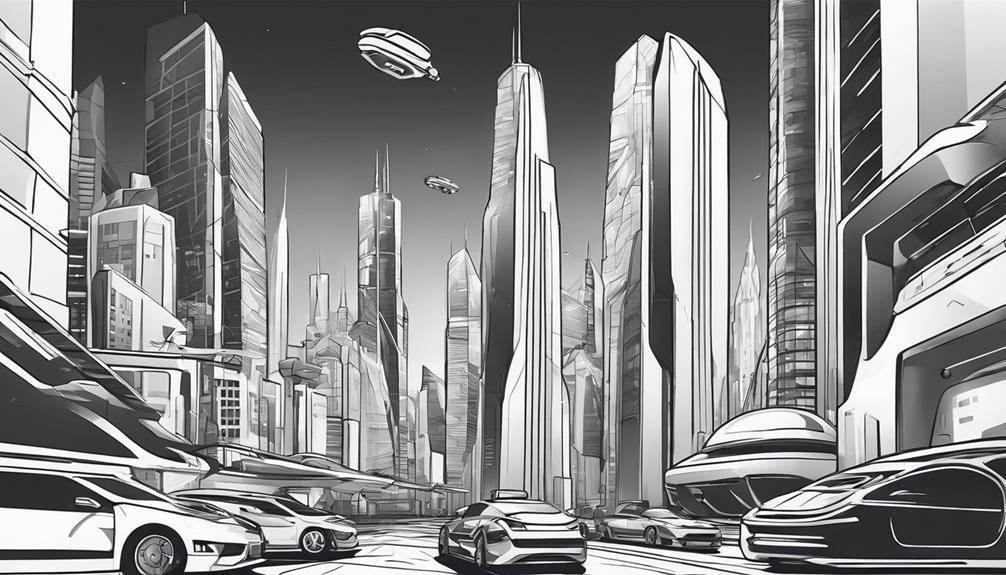
Understanding the public perception and acceptance of flying cars requires a nuanced examination of the factors influencing societal attitudes towards this innovative mode of transportation. Public perception of flying cars has been significantly influenced by futuristic depictions in popular culture, such as movies like 'Back to the Future' and 'The Jetsons.' However, surveys indicate mixed feelings among the public concerning the safety, practicality, and feasibility of flying cars. Concerns surrounding noise pollution, safety regulations, and the readiness of infrastructure also play a pivotal role in shaping public acceptance of flying cars.
Companies like Alef and Aska are actively working to address these concerns and demonstrate the viability of flying cars through technological advancements and safety measures. Public education initiatives, awareness campaigns, and successful demonstrations can potentially play a crucial role in improving public acceptance of flying cars. As these efforts progress, it is essential to engage in open dialogue with the public, address their apprehensions, and showcase the benefits of integrating flying cars into future transportation systems.
Integration With Urban Air Mobility
Integrating flying cars into urban air mobility systems requires meticulous coordination among industry stakeholders, regulatory bodies, and urban planners to address various operational challenges and ensure seamless integration. This integration is crucial for the advancement of transportation systems and urban development. Key aspects to consider in this process include:
- Regulatory Framework: Establishing clear regulations from air navigation service providers is essential to govern the safe and efficient operation of flying cars in urban airspace.
- Infrastructure Development: Adapting infrastructure to accommodate flying cars, such as building vertiports and developing efficient route planning systems, is necessary for the successful implementation of urban air mobility.
- Collaborative Efforts: Industry leaders, regulators, and urban planners must work together to overcome challenges related to noise, pollution, security, sustainability, and licensing requirements, ensuring that the integration of flying cars into urban environments is well-coordinated and beneficial for society.
Role of Automation in Flying Cars
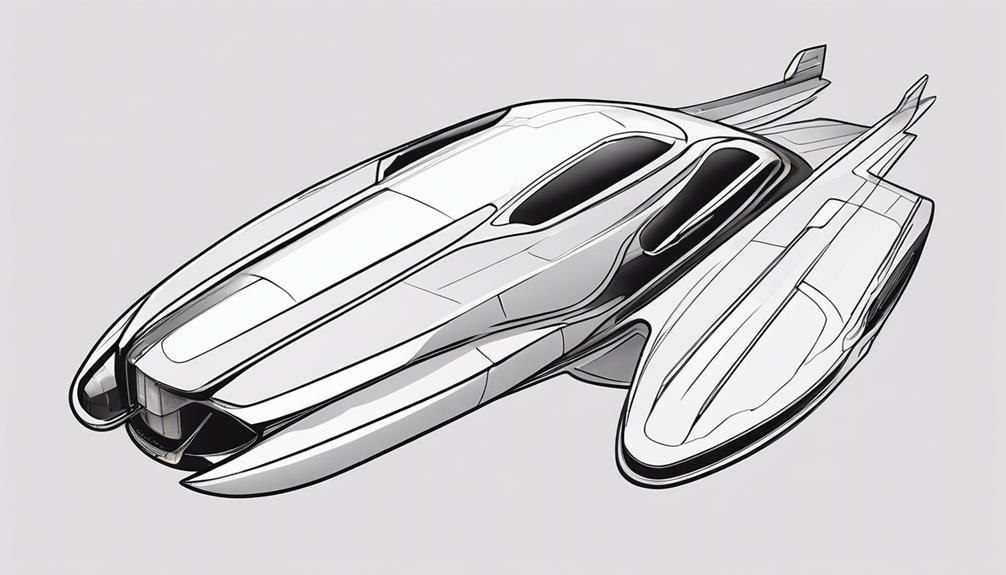
The advancement of flying cars hinges significantly on the integration of sophisticated automation systems to facilitate autonomous flight capabilities and enhance operational safety in urban environments. Automation in flying cars is pivotal for enabling features such as autonomous flight and collision avoidance systems, which are essential for safe and efficient operation within urban settings. By reducing reliance on human pilots, automation plays a crucial role in enhancing the overall safety of flying car transportation. These advanced technologies allow for precise navigation, efficient route planning, and real-time adjustments, ensuring smooth and secure flying experiences for passengers. Moreover, the evolution of automation in flying cars is paving the way for future advancements towards fully autonomous aerial mobility solutions. As automation continues to progress, flying cars are poised to become not just a futuristic concept, but a practical and safe mode of transportation in the urban airspace.
Future Outlook for Flying Cars
In contemplating the future trajectory of flying cars, a pivotal consideration lies in the feasibility of widespread adoption and integration into existing urban transportation systems.
Future Outlook for Flying Cars:
- Technology Advancements: Companies like Aska and Alef are developing flying cars with electric batteries and small gas engines, aiming for a maximum speed of 150 mph and a range of 250 miles on a single charge.
- Urban Integration: These flying car models are designed to fit in conventional parking spaces but require helipad-sized areas for takeoff and landing, potentially enabling long commutes and reducing the number of regular cars owned.
- Autonomy and Production: While initial models may require pilots, full autonomy is predicted by 2030. Companies like Alef are gearing up for production at a rate of 1-2 vehicles per month, with plans to start manufacturing in 2025 or early 2026, pending regulatory approvals.
The future of flying cars holds promise for revolutionizing urban transportation, but challenges such as specialized propeller motor systems and regulatory hurdles must be overcome for these vehicles to soar into the mainstream.
Frequently Asked Questions
Is It Possible to Make a Car Fly?
Achieving flight capabilities in vehicles is a complex engineering feat that requires innovative design, propulsion systems, and safety considerations. The development of flying vehicles involves integrating technologies such as vertical takeoff, efficient propulsion mechanisms, and aerodynamic structures. Addressing challenges like power source efficiency, control systems, and airspace regulations are crucial for making flying cars a reality. Advancements in aviation and automotive industries are driving progress towards the feasibility of creating cars that can fly.
Are Flying Cars Ever Possible?
Advancements in flying technology have led to the development of prototypes demonstrating the feasibility of flying cars. With ongoing research and innovation, the potential for flying cars to become a reality is promising. Challenges in design, power sources, and regulatory frameworks are being addressed to pave the way for the integration of flying cars into transportation systems. Collaborative efforts among industry players and policymakers are crucial for harnessing the full potential of flying technology.
Are They Making a Car That Can Fly?
Flying vehicles represent the pinnacle of futuristic transportation technology. Companies like Aska and Alef are at the forefront of developing cars that can seamlessly transition between road and air travel. These innovative vehicles, with their vertical takeoff and landing capabilities, offer the promise of revolutionizing urban and suburban mobility. Aska A5 and Alef's flying cars, equipped with electric propulsion systems and impressive performance metrics, are poised to redefine the concept of personal transportation.
What Year Will Cars Be Able to Fly?
Advancements in flying technology are rapidly progressing, with predictions pointing towards the commercial availability of flying cars in the near future. The timeline for cars to be able to fly is being propelled closer to reality due to continuous technological innovations. As companies like Alef and Aska A5 strive to introduce flying vehicles by the mid-2020s, the convergence of cutting-edge aviation and automotive technologies is paving the way for a transformative era of transportation.
Conclusion
In conclusion, the development of flying cars requires significant technological advancements, regulatory frameworks, and infrastructure improvements. While safety concerns and environmental impacts must be addressed, the potential benefits of faster travel and reduced congestion are promising. The integration of automation in flying cars holds great potential for the future of urban and suburban transportation. Will flying cars someday revolutionize the way we commute and navigate our cities?
